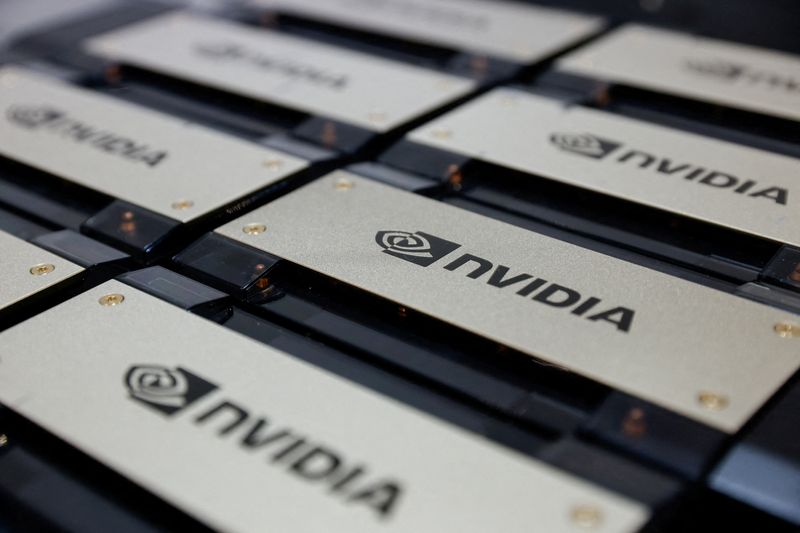Intel stock spikes after report of possible US government stake
SAN JOSE, Calif. - NVIDIA, the semiconductor giant with a market capitalization of $2.84 trillion and a perfect Piotroski Score of 9 according to InvestingPro, has announced the release of its Llama Nemotron family of models, which are designed to enhance AI reasoning capabilities for developers and enterprises. The new models are said to improve multistep math, coding, reasoning, and complex decision-making tasks, with accuracy enhancements of up to 20% and inference speed optimizations of 5x compared to existing models. This innovation comes as NVIDIA maintains its impressive 75% gross profit margin and 114% year-over-year revenue growth.
The Llama Nemotron reasoning models are available in Nano, Super, and Ultra sizes, each optimized for different deployment scenarios. The Nano model is tailored for PCs and edge devices, the Super model for single GPU setups, and the Ultra model for multi-GPU servers.
Companies such as Accenture, Amdocs, Atlassian, Box, Cadence, CrowdStrike, Deloitte, IQVIA, Microsoft, SAP, and ServiceNow are collaborating with NVIDIA to integrate these reasoning models into their services. For example, Microsoft plans to incorporate Llama Nemotron models into its Azure AI Foundry, and SAP is using the models to improve its Business AI solutions and Joule AI copilot. Want deeper insights into NVIDIA’s financial health and growth metrics? InvestingPro offers 20+ additional key metrics and expert analysis in its comprehensive Pro Research Report.
NVIDIA has also introduced new tools and software to support the deployment of these models, including NVIDIA NIM microservices for optimizing inference and enabling continuous learning, as well as the NVIDIA AI-Q Blueprint and NVIDIA AI Data Platform to assist in building collaborative AI systems.
The Llama Nemotron Nano and Super models, along with the NIM microservices, are currently available for development, testing, and research through NVIDIA’s Developer Program. Enterprises can deploy these models in production with NVIDIA AI Enterprise on data center and cloud infrastructure. The NVIDIA AI-Q Blueprint is expected to be available in April, and the NVIDIA AgentIQ toolkit is already accessible on GitHub.
This news is based on a press release statement from NVIDIA, which emphasizes the company’s continued leadership in accelerated computing and agentic AI development. With 25 analysts recently revising their earnings estimates upward and a consensus recommendation of 1.34 (Strong Buy) according to InvestingPro, NVIDIA’s market position appears robust. Discover more detailed analysis and over 30 additional financial metrics with InvestingPro’s comprehensive research tools.
In other recent news, NVIDIA has unveiled a series of significant technological advancements aimed at enhancing AI and robotics capabilities. The company introduced the GR00T N1 model, a foundation model for humanoid robots, during its GTC event. This model is designed to improve humanoid robot reasoning and skills and is available to developers worldwide. NVIDIA also launched the RTX PRO Blackwell GPUs, which are expected to enhance productivity across various professional fields by accelerating workflows in AI, technical, creative, and engineering sectors.
Additionally, NVIDIA announced the release of two personal AI supercomputers, the DGX Spark and DGX Station, which bring the NVIDIA Grace Blackwell architecture to desktops, allowing developers to build and deploy large AI models. The company also introduced energy-efficient AI factory switches, the NVIDIA Spectrum-X and Quantum-X, to optimize networking in AI data centers. These switches promise to significantly reduce energy consumption and operational costs.
Furthermore, NVIDIA revealed the Blackwell Ultra platform, designed to enhance AI reasoning and scaling inference capabilities, expected to deliver 1.5 times the AI performance of its predecessor. The platform includes the GB300 NVL72 and HGX B300 NVL16 systems, aimed at improving AI service quality. NVIDIA’s ongoing collaborations with partners like Google DeepMind and Disney Research continue to support the development of advanced AI and robotics technologies.
This article was generated with the support of AI and reviewed by an editor. For more information see our T&C.
